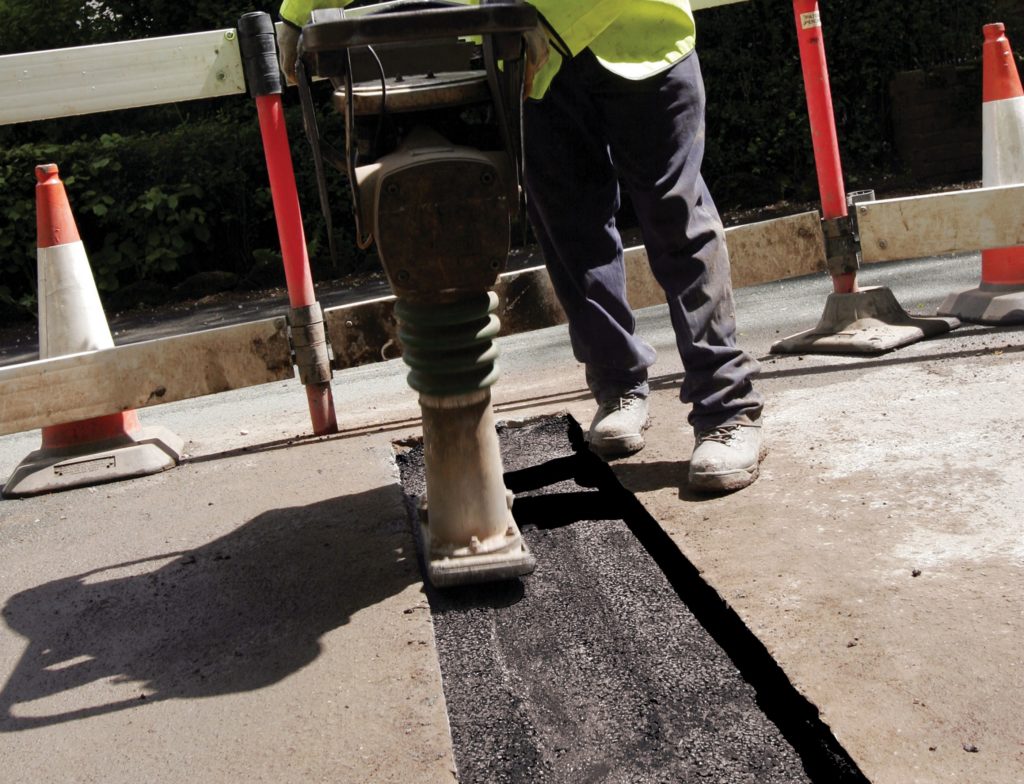
Potholes are a common and frustrating issue for drivers in Austin, and finding the best method to repair them is crucial for maintaining safe and efficient roadways. The two most popular materials used for pothole repairs are asphalt and concrete, each with its own strengths and weaknesses.
As we delve into the world of pothole repair, it’s essential to understand how these materials perform under different conditions, as well as the environmental factors that can contribute to their deterioration.
In this article, we’ll explore the pros and cons of both asphalt and concrete when it comes to repairing potholes in Austin. We’ll discuss how each material reacts to various environmental factors such as temperature fluctuations, rainfall, and traffic load. Additionally, we’ll weigh the long-term durability of each option against their respective costs and ease of installation.
By analyzing research-based information on these materials’ performance in local conditions, we aim to provide a comprehensive comparison to help determine which method is best suited for pothole repairs in our city.
Understanding Potholes: The Role of Materials and Environment
You might be wondering how potholes form and what role materials and the environment play in their creation and repair. Well, let’s dive into that fascinating world together!
Potholes result from water seeping beneath the pavement through cracks caused by traffic wear and tear or other environmental factors. The trapped water expands and contracts as temperatures fluctuate between freezing and thawing, weakening the pavement. Over time, this continuous process leads to the formation of a cavity beneath the road surface that ultimately collapses under vehicle loads, creating a pothole.
Materials play an essential role in both forming potholes and repairing them. The two primary materials used for road construction are asphalt and concrete. Asphalt consists of a mixture of aggregates bound together with bitumen, making it more flexible than concrete due to its higher oil content. However, it is also more susceptible to degradation from freeze-thaw cycles. On the other hand, concrete is composed mainly of cement mixed with aggregates like gravel or crushed stone, making it more resistant to weather-related damage compared to asphalt. Nevertheless, it can still crack under heavy loads or extreme temperature changes.
When considering which material is best for pothole repairs in Austin – asphalt versus concrete – we must take into account not only their inherent properties but also how they perform under local environmental conditions. In Austin’s hot climate with occasional freezes during winter months, road surfaces made from either material face unique challenges. Asphalt roads tend to soften in high heat while being especially vulnerable during freeze-thaw cycles. Meanwhile, concrete surfaces can crack under intense heat or when exposed to significant moisture fluctuations. Ultimately, finding an effective solution for repairing these inevitable damages requires understanding both materials’ strengths and weaknesses within Austin’s specific environment so that we can select a method that will provide long-lasting results for our city’s infrastructure needs.
Asphalt for Pothole Repairs: Strengths and Weaknesses
When it comes to fixing those pesky potholes, let’s dive into the strengths and weaknesses of using asphalt as a solution.
Asphalt is a popular choice for pothole repair due to its low cost, ease of use, and quick setting time. It can be easily applied to the affected area and typically requires less time to set than concrete. Additionally, asphalt offers better flexibility in terms of temperature fluctuations, making it more resistant to cracking from thermal expansion and contraction.
However, there are some disadvantages when using asphalt for pothole repairs. One major concern is its durability compared to concrete. Over time, asphalt tends to wear down faster than concrete due to factors such as weathering and heavy traffic loads. This can lead to more frequent repairs being needed in areas with high traffic volume or harsh environmental conditions.
Furthermore, while asphalt may be able to withstand minor temperature changes better than concrete, it is still susceptible to damage from exposure to UV radiation and chemicals like oils or salts commonly found on road surfaces.
Despite these drawbacks, asphalt remains a widely used material for pothole repair because of its overall effectiveness in restoring damaged pavement surfaces quickly and economically. In Austin’s climate where air temperatures can vary significantly throughout the year – impacting both materials – the ability of asphalt to accommodate these changes might outweigh its shorter lifespan compared to concrete.
Ultimately, the choice between asphalt and concrete will depend on local factors such as budget constraints, traffic patterns, environmental conditions, and specific requirements for each individual project.
The Concrete Approach: Benefits and Drawbacks for Pothole Repairs
In considering the use of concrete for fixing potholes, it’s important to weigh the benefits and drawbacks of this material in comparison to asphalt. Concrete has some unique properties that make it an attractive option for road repairs, but there are also potential downsides that must be taken into account.
1. Longevity: Concrete is known for its durability and can last up to 30-40 years with proper maintenance, which is significantly longer than asphalt’s 12-20-year lifespan. This means fewer instances of repair work over time.
2. Strength: Concrete can handle heavier loads without deforming or cracking under pressure, making it a suitable choice for high-traffic areas or locations frequented by heavy trucks.
3. Environmentally Friendly: The production process of concrete generates fewer emissions compared to asphalt manufacturing, contributing to better air quality overall.
4. Heat Reflectivity: Unlike dark-colored asphalt surfaces that absorb heat and contribute to the urban heat island effect, lighter-colored concrete reflects sunlight and helps keep surrounding areas cooler.
Despite these advantages, there are some factors that may make concrete less appealing when it comes to addressing pothole problems in Austin. For one, concrete repairs tend to be more expensive than their asphalt counterparts due primarily to higher material costs and labor-intensive installation methods involving specialized equipment such as slip-form pavers or volumetric mixers.
Furthermore, curing times may take several days depending on weather conditions – leading to prolonged road closures during the repair process – while comparable asphalt repairs could be completed within hours. Lastly, certain climate conditions in Austin like extreme temperatures or excessive moisture might affect the performance of concrete over time; however, research continues on ways to mitigate these potential issues through innovative products like pervious concrete or supplementary cementitious materials (SCMs).
Weighing these pros and cons will help determine whether a concrete approach is best suited for addressing Austin’s pothole problem effectively and efficiently.
Comparing Asphalt and Concrete in the Realm of Pothole Repairs
It’s crucial to compare the performance of both materials when addressing pothole repairs, as each offers unique advantages and disadvantages that may impact their effectiveness in Austin’s climate.
To begin with, let’s consider how asphalt and concrete handle temperature fluctuations and weather-related stressors. Asphalt is known for its ability to expand and contract with varying temperatures, making it a suitable choice for areas prone to freeze-thaw cycles. In contrast, concrete can be more susceptible to cracking under extreme temperature changes due to its rigid nature; however, it retains strength during high heat exposure.
Next, we must examine the longevity and durability of each material in relation to pothole repairs. Concrete boasts a longer life expectancy than asphalt, often lasting upwards of 30 years with proper maintenance. Meanwhile, asphalt typically requires more frequent maintenance and repair over its lifespan of approximately 20 years.
This difference in durability can lead to additional costs associated with repairing or replacing damaged asphalt surfaces compared to those made from concrete. However, one should also take into account that asphalt is generally less expensive than concrete at initial installation.
When comparing these two materials specifically for pothole repairs in Austin’s climate conditions, several factors come into play: cost-effectiveness, ease of application/repair process, environmental considerations (such as heat island effect), and overall sustainability within the urban environment.
While both have their pros and cons based on these criteria, ultimately determining which material is best suited for use will depend on local priorities such as budget constraints or specific environmental goals set forth by city planners or engineers involved in roadway projects throughout the area.
Factors to Consider When Choosing a Pothole Repair Material in Austin
Picking the perfect pothole patching product in Austin is a piece of cake, provided you ponder a plethora of pivotal factors. As we know, Austin experiences scorching summers and mild winters, which can cause damage to both asphalt and concrete surfaces. Furthermore, with the city’s ever-growing population and thriving economy comes increased traffic that puts more strain on roadways.
To make an informed decision when choosing between asphalt or concrete for pothole repairs in Austin, it’s crucial to take into account local climate conditions and traffic patterns. Specifically:
– Assessing how local climate affects the longevity of repair materials: In Austin’s hot weather, asphalt has a tendency to soften and lose its structural integrity over time, leading to further damage. Concrete, on the other hand, may better withstand high temperatures but could crack due to temperature fluctuations during freeze-thaw cycles.
– Evaluating the impact of traffic volume on repair durability: Heavily-trafficked areas require materials that can withstand constant wear and tear from vehicles passing over them daily. Asphalt offers greater flexibility under pressure compared to rigid concrete but may need more frequent maintenance as a result.
– Considering cost-effectiveness: While asphalt is typically less expensive than concrete upfront, it may require additional long-term maintenance costs due to its susceptibility to degradation from heat and heavy traffic.
By considering these factors along with seeking professional consultation from experienced professionals in the field of road repairs and construction materials, we can ensure that we choose the best method for pothole repairs in Austin—whether it be asphalt or concrete—to maintain our roads’ safety and functionality while keeping costs within budgetary constraints. Ultimately, knowledge about local conditions combined with expert advice will help us select a suitable material for repairing potholes in this bustling Texan city while preserving its infrastructure for years to come.
Conclusion
In the end, it’s like choosing between apples and oranges when it comes to fixing potholes in Austin. Both asphalt and concrete have their own unique flavors, strengths, and weaknesses that can either make or break our pavement repair endeavors.
So, let’s keep our eyes peeled for the best method that suits our specific needs. After all, it’s essential to weigh the pros and cons of both materials before diving headfirst into a pothole repair project in the dynamic city of Austin.

